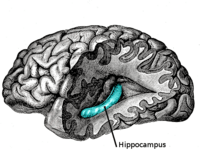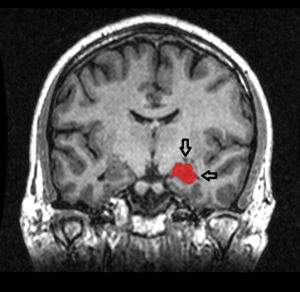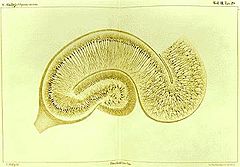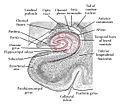Hippocampus facts for kids
- For the small fish, go to seahorse
| Brain: Hippocampus | ||
|---|---|---|
Quick facts for kids
|
||
| The hippocampus is located in the medial temporal lobe of the brain. In this lateral view of the human brain, the frontal lobe is at the left, the occipital lobe at the right, and the temporal and parietal lobes have largely been removed to reveal the hippocampus underneath. | ||
| Hippocampus (lowest pink bulb) as part of the limbic system |
||
| Latin | Hippocampus | |
| Part of | Temporal lobe | |
The hippocampus is an important part of your brain. Humans and other mammals have two of them, one on each side of the brain. The hippocampus is found deep inside your brain, under the cerebral cortex.
It helps you remember things, especially where you are and how to get around. It also helps turn your short-term memories (like what you had for breakfast) into long-term ones (like your favorite childhood memories). The hippocampus gets its name because it looks a bit like a seahorse.
If the hippocampus gets damaged, it can cause problems with memory. For example, in Alzheimer's disease, the hippocampus is one of the first parts of the brain to be affected. This can lead to memory loss and confusion. People with serious damage to both hippocampi might not be able to form new memories at all. This is called anterograde amnesia.
Scientists often study the hippocampus to learn how the brain works. They have found that it plays a big role in how our brains store memories.
Contents
How the Hippocampus Helps Us Remember
Scientists learned a lot about the hippocampus and memory from a famous case. A patient had surgery to help with severe epileptic seizures. During the surgery, parts of his hippocampi were removed. After the surgery, something unexpected happened: he could not form any new memories. He also couldn't remember things that happened just before his surgery. However, he could still remember events from many years earlier, even from his childhood.
This case showed how important the hippocampus is for memory. Since then, many other patients with similar brain damage and memory loss have been studied. Scientists have done thousands of experiments to understand how the brain's connections, called synaptic connections, change in the hippocampus when we learn and remember.
Even though we know the hippocampus is key for memory, scientists are still working to understand exactly how it works. Recent studies suggest that the hippocampus helps us put together our memories of past events. It also helps us remember different parts of complex experiences.
Hippocampus and Finding Your Way
The hippocampus also helps us understand where we are in our environment. Studies on rats and mice have shown that certain neurons (brain cells) in their hippocampus become active when the animal is in a specific place. These are called "place cells." It's like these cells have a built-in GPS!
Scientists have also found similar cells in humans. In one study, patients with epilepsy had tiny electrodes placed in their hippocampus. They then used a computer to move around in a virtual reality town. The results showed that some of their brain cells also fired when they were in certain virtual locations.
The discovery of these "place cells" in the 1970s led to a theory called the "cognitive map hypothesis." This idea suggests that the hippocampus creates a mental map of our surroundings. This helps us navigate and find our way around. Other discoveries, like "direction cells" in parts of the brain connected to the hippocampus, support this idea even more.
How the Hippocampus Changed Over Time
The hippocampus looks pretty similar in most mammals, from monotremes like the echidna to primates like humans. However, its size compared to the body's size changes. For example, it's about twice as large in primates as it is in an echidna. But it doesn't grow as fast as the neocortex (the outer layer of the brain). This means the hippocampus takes up a bigger part of the brain in animals like rodents than it does in primates.
Other animals that are not mammals also have parts of their brain that might be similar to the hippocampus. Some insects and sea creatures like the octopus are very good at learning about places and finding their way. However, their systems seem to work differently from how the mammalian hippocampus does. They probably developed these abilities on their own, over a long time.
Images for kids
-
Image 1: The human hippocampus and fornix (left) compared with a seahorse (right)
-
Image 2: Cross-section of cerebral hemisphere showing structure and location of hippocampus
-
Image 3: Coronal section of the brain of a macaque monkey, showing hippocampus (circled)
-
Image 4: Basic circuit of the hippocampus, as drawn by Cajal DG: dentate gyrus. Sub: subiculum. EC: entorhinal cortex
-
Image 6: Spatial firing patterns of 8 place cells recorded from the CA1 layer of a rat. The rat ran back and forth along an elevated track, stopping at each end to eat a small food reward. Dots indicate positions where action potentials were recorded, with color indicating which neuron emitted that action potential.
-
Image 7: Examples of rat hippocampal EEG and CA1 neural activity in the theta (awake/behaving) and LIA (slow-wave sleep) modes. Each plot shows 20 seconds of data, with a hippocampal EEG trace at the top, spike rasters from 40 simultaneously recorded CA1 pyramidal cells in the middle (each raster line represents a different cell), and a plot of running speed at the bottom. The top plot represents a time period during which the rat was actively searching for scattered food pellets. For the bottom plot the rat was asleep.
See also
 In Spanish: Hipocampo (anatomía) para niños
In Spanish: Hipocampo (anatomía) para niños


